Two Stacks: relevance essential for driving growth
By Georgie CollinsIndependent Irish whiskey bottler Two Stacks has gone from strength to strength since it was established in 2020. We chat with co-founder Shane McCarthy about how the brand championed flavour and innovation to attract new drinkers to the category.
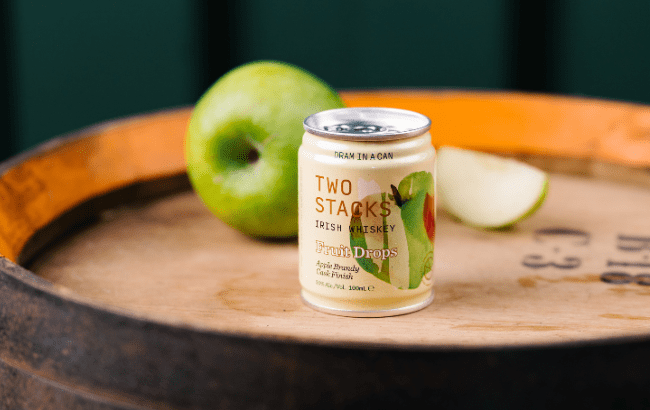
It’s tricky to avoid negative sentiment in the spirits industry at the moment. Economic unrest brought on by a cost-of-living crisis, a decline in consumer alcohol consumption, and sky-rocketing interest rates breeds uncertainty, especially among spirits producers, but whiskey blender McCarthy has a positive outlook on how things are going for his brand, Two Stacks.
“I think for us, we’ve been very beneficial in that we’ve definitely been against the curve of it all,” he tells The Spirits Business from his home in Northern Ireland. “We’ve continued to have year-on-year growth and momentum – and really, really big growth at that – which is great, and you know, that momentum is just building in the market.”
He believes that while doom and gloom often dominates the headlines, the Irish whiskey sector is going through a revival period, similar to the one Scotch whisky experienced in the 1990s and early 2000s, which is something to be celebrated. “It’s all happened before. We studied how Scotch reset and took off again, and I think that’s just fixing itself at the moment on the island. There’s certainly a lot of positive things, but people just tend to hone in on the negative side of things.”
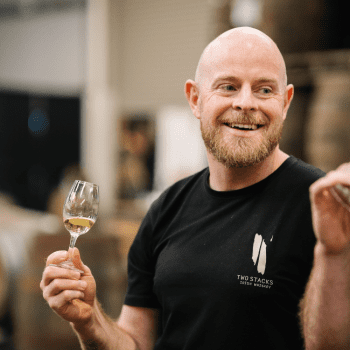
McCarthy founded Two Stacks alongside Liam Brogan and Donal McLynn, having been inspired by both traditional and contemporary brands in the Irish whiskey sector. The trio opened one of Ireland’s only independent bonding and blending facilities in 2022, with the ambition of combining the two worlds.
“We’re definitely always about that positive sentiment. If you look at bonders in the history of whiskey over 700 years, they were quite vital in actually being the cash cow for distilleries,” he explains. “A lot of distilleries just would have focused on manufacturing, whereas the bonders and merchants were buying up all that liquid really quickly. I actually feel we need more indie bottlers in Ireland, and we need more bonders to really bring the industry along.”
The Irish whiskey category has definitely seen a renaissance in the past few years. In March this year, the Irish Whiskey Association (IWA) published its latest Irish Whiskey in Numbers report, which revealed sales had exceeded 15 million cases in 2024.
However, McCarthy notes that for the category to continue its growth, new distilleries need to be strategic about their marketing, understand their target audience, and create a product that stands out in a competitive market.
“It’s fascinating – some of these mid-sized distilleries are putting £10-, £15-, £20 million into the infrastructure, and then they really skimp on their sales and marketing, maybe hiring one person from somewhere, and then thinking it’s just going to sell, and it’s like, wow, you’ve done this the whole wrong way around. You have to be relevant. You can’t bring sand to the beach. That’s very much what we focused on when we set out with Two Stacks.”
Creativity and innovation, he says, is also one of the keys for growing the Irish whiskey category.
“For me, the word innovation, I kind of don’t like it. I think it’s thrown around too much – but I would say we certainly were first movers.”
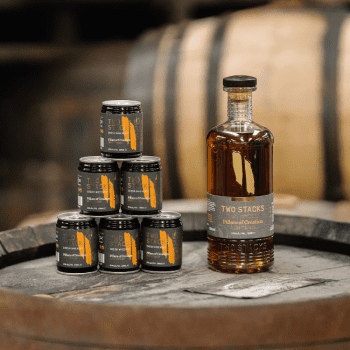
Two Stacks was the first producer to “put whiskey in the can before anyone else did it,” he says, noting that the same goes for the brand’s Irish cream expression. “We’ve done lots of other pioneering things around the Fruit Drops range, and that was really to enhance and bring more people into the demographic.”
These ‘first moves’ into these groundbreaking spaces within the category have been underscored by the brand’s prioritisation of the thoughtful design of its products.
“We look very closely at Japanese design and Scandinavia, and that minimalism, where they are actually engaging the consumer,” he says. “There’s a lot of thought that goes on in the background – a lot of really detailed thought. I think that’s maybe where you could say we have innovated. And you know, the formats and the vessels that we’re putting it into has just allowed whiskey to become more accessible, you know – not this kind of high-brow space that people are afraid to touch sometimes. So that’s a lot of what I think we’ve done well.”
Dram in a Can
The Two Stacks ‘Dram in a Can’ concept, which sees 100ml servings of the brand’s Irish spirits presented in a portable, light-weight travel-ready format, has been one of the innovations that has allowed this relatively young brand to stand out in the market. Since launch, more than three million units from the range have been sold.
“We’re making some great inroads with Dram in a Can, actually. And it comes down to, I think, great product, and the unit economics – it’s like €6.50, and the taxes are so high, so people just see value and quality. It’s really reinforced our position as a quality brand in the space, because I think we very easily could have got it wrong with the can – we could have cheapened the whole visual and aesthetics of it.
“But what we set out to do was get liquid on lips – get people trying different Irish whiskey. It was like sending out miniature bottles, but we’ve sold millions of these cans. We sold over three million units in a couple of years, and there’s no way we would sell over three million bottles, you know? So to me it’s like commitments to the brand – sharing and experiencing differently – so I think we’ve done it justice.”
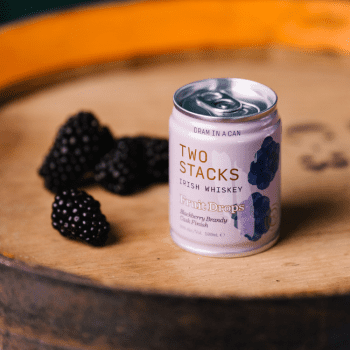
While some brands have attempted to follow suit and offer spirits in cans, McCarthy notes that few have managed to do the format justice, though he would love to see more success as it makes the spirit more approachable.
“The cans are like your whiskey flask, and for five bucks that’s quite a substantial amount of premium whiskey. I think the way the markets going at the minute, it’s just leaned into the Dram in a Can because some people maybe don’t want to pay £40 for a bottle when they can grab two cans and just have a nip of whiskey – I think that’s where it’s won the day and won hearts and minds. And yes, of course, you have the purists that have said they won’t touch whiskey in a can but I think it’s been 0.1% – you’ll always get the naysayers.”
But it’s not the whiskey purists that Two Stacks is trying to reach with Dram in a Can, McCarthy says, but rather a new audience that are perhaps coming to whiskey for the first time. “It is to bring in new drinkers,” he explains. “And it’s actually the female audience that has seen probably the biggest growth, because we see it on our e-commerce data.
“I think, as a whole, women are probably the fastest growing whiskey consumer. Certainly that’s where we’re seeing more adoption, even at whiskey trade shows. I love it – it shouldn’t be male or female, or this person or that person. It’s for everyone, but I definitely think the Fruit Drops range grabs the female attention. So that’s probably where we see the biggest growth in who’s drinking Two Stacks.”
Fruit Drops
The Fruit Drops range first debuted in February, and is a range of whiskeys finished in casks sourced from California, where natural fruits were used for distillation and then aged in Bourbon. The series offers three 50% ABV expressions: Apricot Fruity Brandy Cask, Apple Fruit Brandy Cask and Blackberry Fruit Brandy Cask, all of which were crafted over the course of 14 months.
The range was released in both 700ml bottled format, and in the 100ml cans, the first batch of which sold out in a matter of weeks.
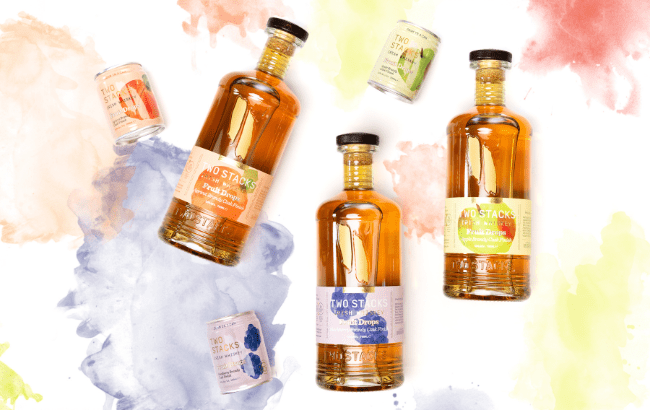
He adds: “Just culturally, you know, it’s a different way of experiencing and getting people into the story of whiskey, because once you start that, you just go on a journey with it, you know? It can be a decade later and you’re still exploring it and learning and developing. But yeah, Fruit Drops was definitely a big focus for us to be like, how do we bring more people in?”
McCarthy references the gin category and the success it saw when branching out into flavoured expressions, noting that the opportunity is there within the whiskey category, too. “That’s what Fruit Drops will prove, and has started to prove. And you know, the three flavours were all intentionally chosen, as well,” he says, sharing that when Two Stacks launched almost five years ago, the team got their hands on apricot brandy, and realised that no whiskey producer had ever experimented with something like that before, “so we thought let’s give it a go. It had this big kind of lovely pear, peachy note in the cask. And when we launched it, everyone just went crazy for it, so we’re like, oh, shit, we’re on something here.”
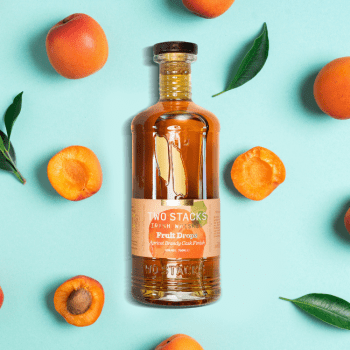
Due to regulations in the Scotch whisky category, stone fruit cask finishes are not allowed, however no such regulation exists within Irish whiskey, which has allowed for Two Stacks to “play it differently”.
“It allows that experimentation to broaden, so that was the main reason apricot is the first in the Fruit Drops line up. And then apple brandy, with Two Stacks being in Armagh – the orchard county – it’s a very appealing fruit. And finally, when we looked at some of the research, berry is still one of the biggest growing categories in flavoured gins, so we were like, okay, do we do raspberry or blackberry?”
It was reaction at trade shows that finalised that decision. “At The Whisky Show last year, there was a couple of influencers that said [blackberry] was the most interesting whiskey they had ever tried,” he shares, confirming that that was the deciding factor for the blackberry brandy expression.
Going forward, the team hasn’t ruled out adding more fruit brandy finishes to the range, sharing that the thus far unreleased raspberry brandy-finished expression won Ireland’s best blend at the World Whisky Awards this year, beating Midleton Very Rare. “It just shows you that flavour wins the day, and it doesn’t have to be these certain profiles that people think.”
He suggests that the raspberry expression will hopefully be released with a retailer down the line, and a pear brandy-finished expression will be released via the website in the coming weeks. “We’ve collaborated with a local artist who’s going to hand paint all the bottles in this beautiful, kind of abstract pear colour, so we’ll just drop 100 bottles of that, but the three core expressions are what we’ve laid down most, so that’s really the only three that we can scale at the minute.”
Reaching a crossroad
McCarthy believes that with all this in mind, the Irish whiskey category now finds itself at a crossroads, with brands that lean into heritage, age statements and classic production methods on one path, and those such as Two Stacks, which favour innovation, creativity and risk taking, on the other.
However while there are many distillers that are confidently walking the heritage path, there seems to be a gap in experimentation elsewhere in the industry, and the risk, he explains, is that without bold innovation, brands can end up stuck in a no man’s land of not traditional enough to appeal to purists, nor fresh enough to attract adventurous drinkers.
Understanding why a product matters to consumers is therefore one of the biggest challenges being found at this crossroads, with market fatigue one of the biggest concerns for producers who fear the sector may become saturated with too many similar offerings.
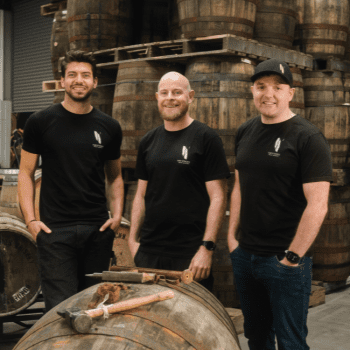
As such, he suggests that the industry, on both sides of the path, needs to innovate thoughtfully while maintaining high standards and telling compelling stories. Furthermore, he believes the most successful brands will balance tradition with innovation, creating products that are both respectful of whiskey’s heritage and exciting for modern consumers.
Yet, this foggy middle ground isn’t just a challenge for whiskey, but rather it reflects a wider shift in consumer behaviour across many categories. “What I’m certainly seeing in retail and consumer buying habits is there’s this no man’s land at the minute, and you just don’t want to be in there,” he says, explaining shoppers are increasingly polarised, either trading up to premium products like Champagne or scaling down to value options like inexpensive wines.
For whiskey brands in this space, it’s no longer enough to simply exist. They need a clear reason for consumers to care – and spend. Otherwise, they risk heavy discounting at retail and dwindling buyer interest, a scenario playing out not only in spirits but also across food and grocery sectors.
“To be that premium, you have to have super advocacy, because why would they be paying over £100 for a new brand? So if you’re going after it, you really have to know why the product is relevant in the market, because otherwise you’re going to lose in a big way.”
However, amid these challenges, McCarthy says there are bright spots. Collaborative projects like Two Stacks’ latest series, Pillars of Creation, which brings together multiple Irish distilleries, demonstrates how shared growth and mutual support can lift the entire category.
“Everyone has to play well at the table, because we’re actually all in this together, so bringing everyone along and up together, I think you need to do that – rising tides lift all boats and all that good stuff,” he says.
Related news
IWA launches ‘landmark’ tourism initiative for Irish whiskey
